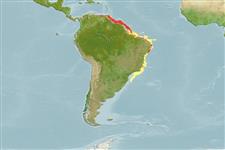Elasmobranchii (haaien en roggen) (sharks and rays) >
Carcharhiniformes (Ground sharks) >
Triakidae (Houndsharks) > Triakinae
Etymology: Mustelus: Latin for weasel, an ancient name for sharks, possibly referring to the pointed snouts, swift movements and/or rapacious feeding behavior of smaller predatory sharks [strictly not tautonymous with Squalus mustelus Linnaeus 1758 since type was designated by the ICZN] (See ETYFish); higmani: In honor of American fisheries biologist James B. Higman (1922-2009), U.S. Fish and Wildlife Service, for his “initial interest in the species and his care in the preparation of excellent notes on its natural history” while serving as an observer on the vessel from which it was collected (See ETYFish).
Eponymy: James Booth Higman (1922–2009) was an American fisheries biologist. [...] (Ref. 128868), visit book page.
Environment: milieu / climate zone / depth range / distribution range
Ecologie
marien; brak water demersaal; diepte 1 - 900 m (Ref. 55584). Deep-water; 11°N - 36°S
Western Atlantic: northern coast of Venezuela southward to Brazil.
Lengte bij maturiteit / Grootte / Gewicht / Leeftijd
Maturity: Lm ?, range 48 - ? cm
Max length : 77.4 cm TL mannelijk / geslacht onbekend; (Ref. 126011); common length : 55.0 cm TL mannelijk / geslacht onbekend; (Ref. 5217); max. gepubliceerd gewicht: 1.6 kg (Ref. 126011)
Found on the continental shelf on muddy, sandy and calcareous bottoms. Also occurs in shallow brackish water. Feeds mainly on crustaceans and occasionally on bony fishes, squids, and coelenterates. Viviparous (with yolk-sac placenta), with 1 to 7 young per litter. Catches consisting of mainly adults of one sex suggest at least partial sexual segregation. Utilized for human consumption.
Viviparous, with a yolk-sac placenta (Ref. 244).
Compagno, L.J.V., 1984. FAO Species Catalogue. Vol. 4. Sharks of the world. An annotated and illustrated catalogue of shark species known to date. Part 2 - Carcharhiniformes. FAO Fish. Synop. 125(4/2):251-655. Rome: FAO. (Ref. 244)
Status op de Rode Lijst van het IUCN (Ref. 130435: Version 2024-1)
Gevaar voor de mens
Harmless
Gebruik door de mens
Visserij: commercieel
Tools
Speciale rapporten
Download XML
Internetbronnen
Estimates based on models
Preferred temperature (Ref.
123201): 9.6 - 24.1, mean 15.4 °C (based on 49 cells).
Fylogenetische diversiteitsindex (Ref.
82804): PD
50 = 0.5000 [Uniqueness, from 0.5 = low to 2.0 = high].
Bayesian length-weight: a=0.00158 (0.00105 - 0.00239), b=3.14 (3.02 - 3.26), in cm total length, based on LWR estimates for this species & Genus-body shape (Ref.
93245).
Trofisch niveau (Ref.
69278): 3.6 ±0.3 se; based on diet studies.
Weerstandsvermogen (Ref.
120179): Zeer laag, minimale populatieverdubbelingstijd meer dan 14 jaar (Fec=1).
Fishing Vulnerability (Ref.
59153): Moderate to high vulnerability (51 of 100).
